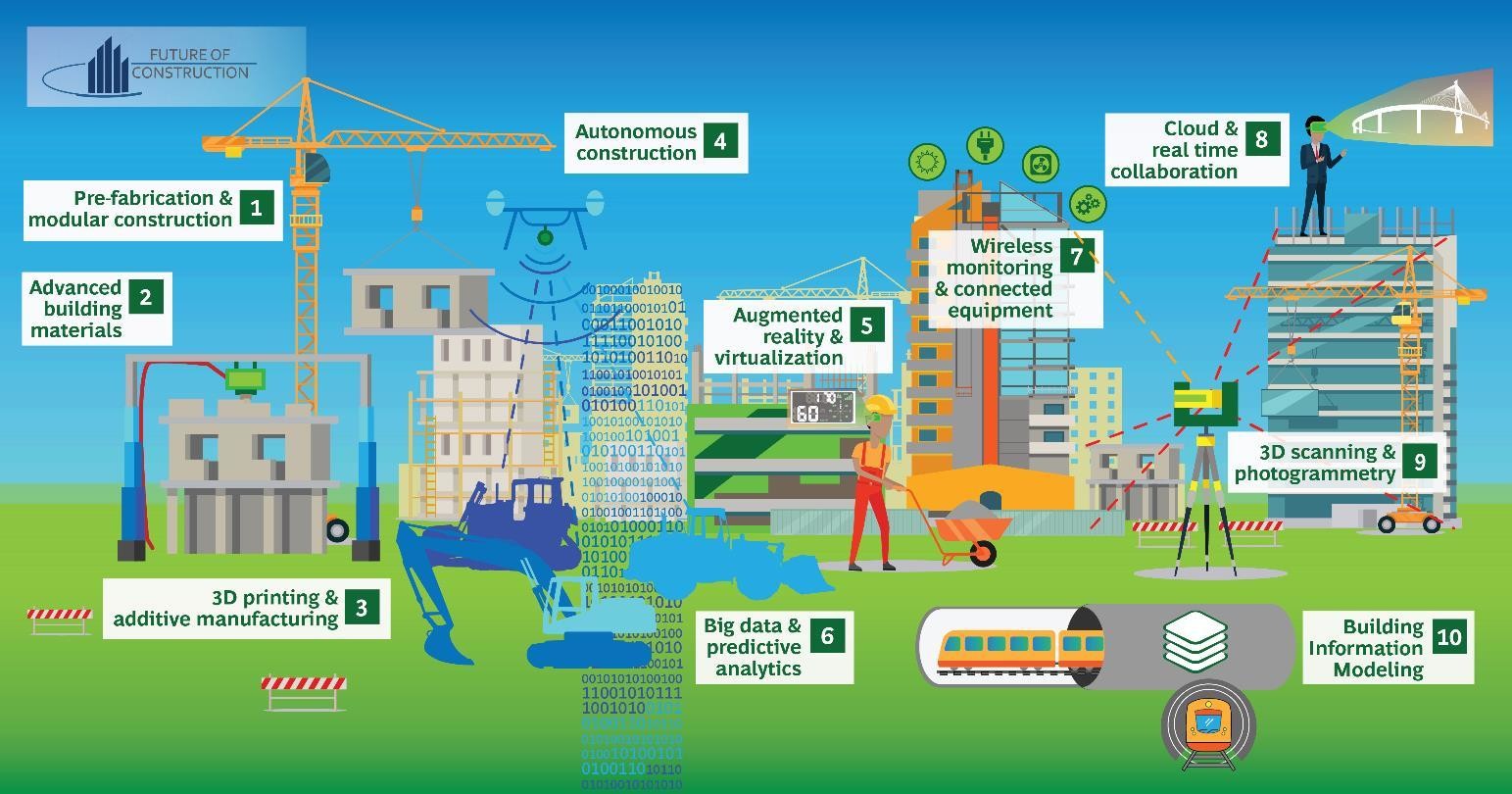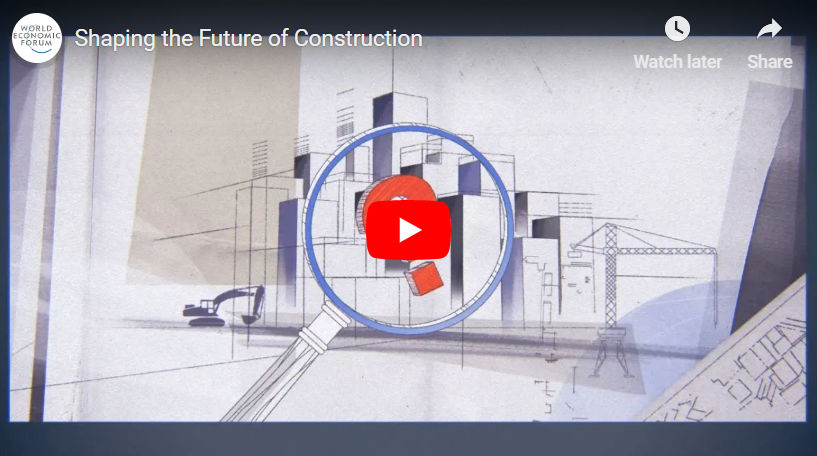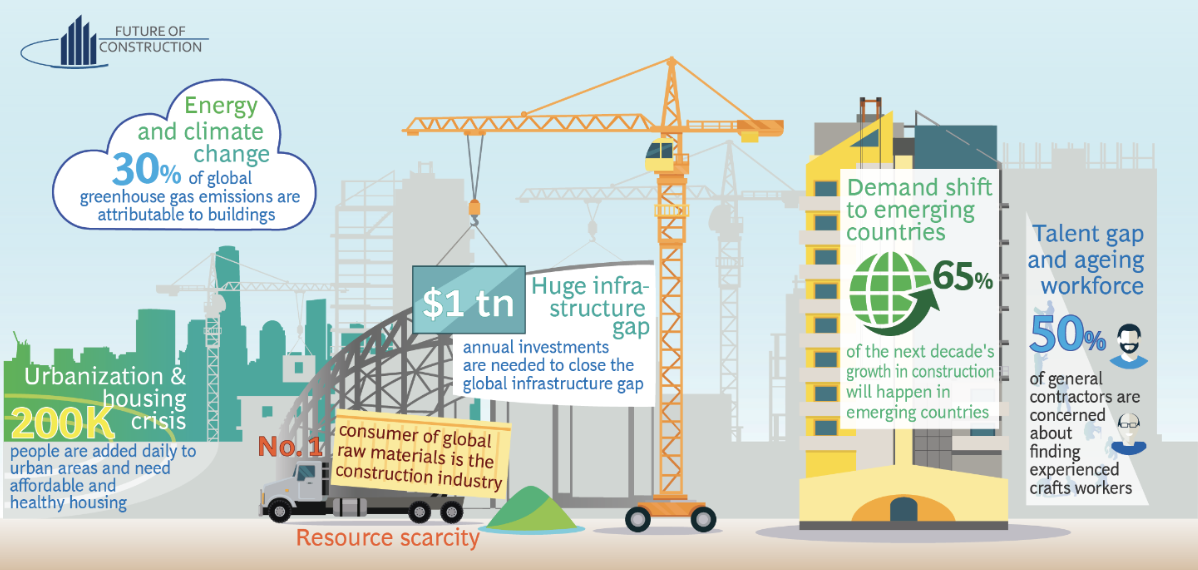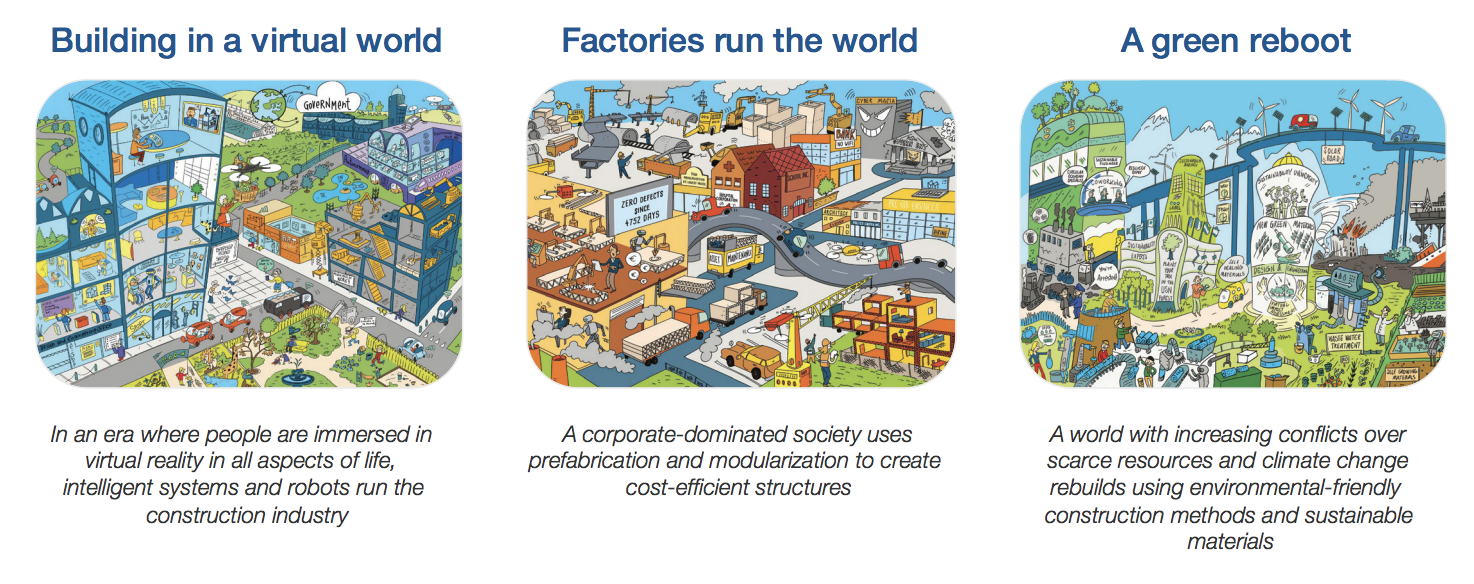The Fourth Industrial Revolution is about to hit the construction industry. Here’s how it can thrive
Over the past decade, digital progress has transformed whole industries, ushering in a new technological era now known as the Fourth Industrial Revolution. Platforms and streaming services such as Facebook, Spotify and Netflix have transformed media and entertainment. E-commerce giants including Amazon and Alibaba have disrupted bricks-and-mortar retailers. Digital mobility companies are challenging automotive manufacturers.
These new technologies are not only satisfying consumer demand for better entertainment, shopping and transport. Innovation has improved companies’ productivity and sustainability, and redefined the skills and competencies needed to thrive.
However, over the same period, the construction industry has continued to operate as it has for the past 50 years. It still relies heavily on manual labour, mechanical technology and established operating and business models. As a result, productivity has stagnated.
Only recently have digital technologies begun to enter the industry, gradually changing how infrastructure, real estate and other built assets are designed, constructed, operated and maintained. These technologies, including building information modeling (BIM), prefabrication, wireless sensors, 3D printing and automated and robotic equipment, are affecting the entire industry. Their economic and social impact could be substantial, given that the construction industry accounts for 6% of global GDP.
Within a decade, full-scale digitization could help the industry escape its decades-long stagnation and generate an estimated 12-20% in annual cost savings, equal to between $1 trillion and $1.7 trillion, according to our estimates.
Global megatrends should also motivate businesses to rethink industry practices that have not advanced. Climate change, resource depletion, a widening talent gap and rapid urbanization - more than 200,000 people are moving into cities from rural areas every day - are but a few of these trends.
Within a decade, full-scale digitization could help the industry escape its decades-long stagnation and generate an estimated 12-20% in annual cost savings, equal to between $1 trillion and $1.7 trillion, according to our estimates.
Global megatrends should also motivate businesses to rethink industry practices that have not advanced. Climate change, resource depletion, a widening talent gap and rapid urbanization - more than 200,000 people are moving into cities from rural areas every day - are but a few of these trends.
A new report, Shaping the Future of Construction: Future Scenarios and Implications depicts three potential outcomes based on these new forces. The future is likely to include elements of each one.
"Current business models, strategies and capabilities will not be sufficient in any of these future worlds", says Michael Burke, Chairman and CEO of AECOM and Co-Chair of the World Economic Forum Infrastructure and Urban Development community.
"Players along the construction value chain need to prepare strategically to thrive in the face of anticipated disruption."
To keep up, attracting new talent and improving the skills of the existing workforce were deemed priorities by 74% of industry CEOs at the 2018 World Economic Forum in Davos. Improving integration and collaboration along the value chain (65%) and adopting advanced technologies at scale (61%) were other key actions they considered.
"The construction industry’s decision-makers should understand the disruption outlined in the future scenarios as a wake-up call. They should use the identified key actions to prepare and shape a prosperous future that will allow the industry to fulfil its role in promoting economic growth, social progress and environmental responsibility", says Luis Castilla, CEO of Acciona Infrastructure and champion of the World Economic Forum Future of Construction initiative.
Several scenarios were created by the World Economic Forum and 30 companies for how the industry could look in the future, based on global trends. They clearly show that existing capabilities, business models and strategies will not be sufficient for success. The scenarios also pinpoint several common no-regret moves that companies should take to remain relevant.
Our key conclusion is that businesses must act now to circumvent future disruption. Dramatic changes on the horizon indicate an uncertain future for the global industry and its more than 100 million employees. The following actions will be relevant, whatever unfolds:
- Attract new talent and build up required skills: Any future scenario requires talent with substantially different skills than today's workforce. Adequate upskilling processes are largely not in place.
- Integrate and collaborate across the construction industry’s value chain: The construction industry is characterized by a disintegrated and highly fragmented value chain, which hampers the seamless data flows and integrated systems that are essential in any future scenario.
- Adopt advanced technologies at scale: The construction industry has been slow to adopt new technologies. It still relies heavily on manual labour and mechanical technologies, resulting in poor productivity.
- Maximize the use of data and digital models throughout processes: This involves reviewing existing practices and infrastructure asset portfolios, to embrace new business opportunities and enable change management.
The myriad potential changes in the construction industry lead to high ambiguity and make it impossible to predict what lies ahead. However, with scenario planning, involved stakeholders can prepare for a variety of possible futures.
Read more of our reports here:
- Shaping the Future of Construction: Future Scenarios and Implications
- Shaping the Future of Construction: An Action Plan to Accelerate Building Information Modeling (BIM) Adoption
- Shaping the Future of Construction: An Action Plan to solve the Industry’s Talent Gap
Written by:
- Michael Buehler, Head of Infrastructure & Urban Development, World Economic Forum
- Pierre Patrick Buffet, Director of Analysis and Strategy, CEO Office , ACCIONA Infraestructuras
- Santiago Castagnino, Partner & Managing Director, Madrid, The Boston Consulting Group
The views expressed in this article are those of the author alone and not the World Economic Forum.
Please find the original article here. This article was also published on the Future of Construction Knowledge Sharing Platformand the WEF Agenda Blog
[edit] Related articles on Designing Buildings Wiki
Featured articles and news
Latest Build UK Building Safety Regime explainer published
Key elements in one short, now updated document.
UKGBC launch the UK Climate Resilience Roadmap
First guidance of its kind on direct climate impacts for the built environment and how it can adapt.
CLC Health, Safety and Wellbeing Strategy 2025
Launched by the Minister for Industry to look at fatalities on site, improving mental health and other issues.
One of the most impressive Victorian architects. Book review.
Common Assessment Standard now with building safety
New CAS update now includes mandatory building safety questions.
RTPI leader to become new CIOB Chief Executive Officer
Dr Victoria Hills MRTPI, FICE to take over after Caroline Gumble’s departure.
Social and affordable housing, a long term plan for delivery
The “Delivering a Decade of Renewal for Social and Affordable Housing” strategy sets out future path.
A change to adoptive architecture
Effects of global weather warming on architectural detailing, material choice and human interaction.
The proposed publicly owned and backed subsidiary of Homes England, to facilitate new homes.
How big is the problem and what can we do to mitigate the effects?
Overheating guidance and tools for building designers
A number of cool guides to help with the heat.
The UK's Modern Industrial Strategy: A 10 year plan
Previous consultation criticism, current key elements and general support with some persisting reservations.
Building Safety Regulator reforms
New roles, new staff and a new fast track service pave the way for a single construction regulator.
Architectural Technologist CPDs and Communications
CIAT CPD… and how you can do it!
Cooling centres and cool spaces
Managing extreme heat in cities by directing the public to places for heat stress relief and water sources.
Winter gardens: A brief history and warm variations
Extending the season with glass in different forms and terms.
Restoring Great Yarmouth's Winter Gardens
Transforming one of the least sustainable constructions imaginable.



























